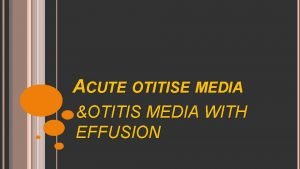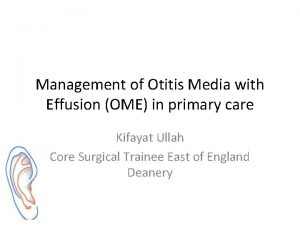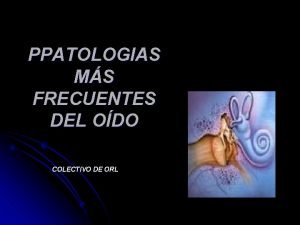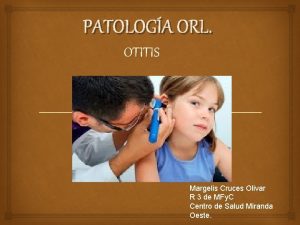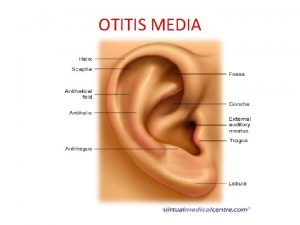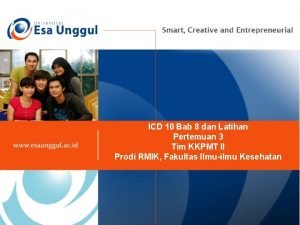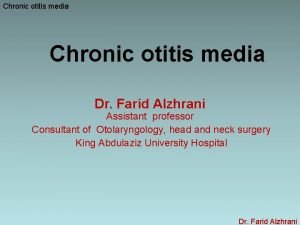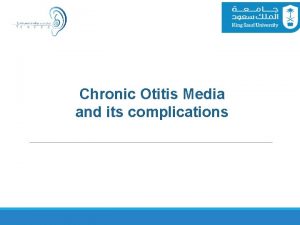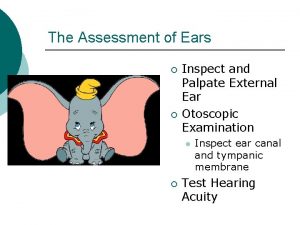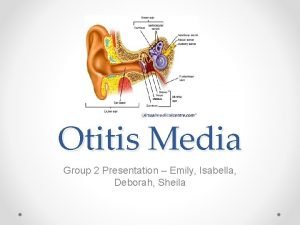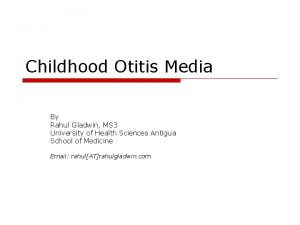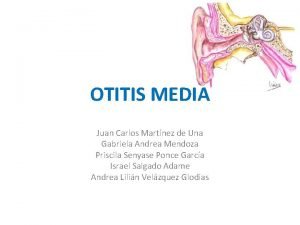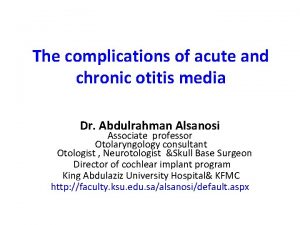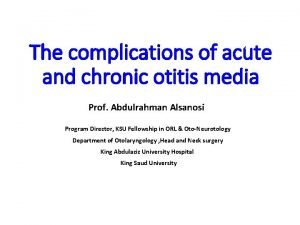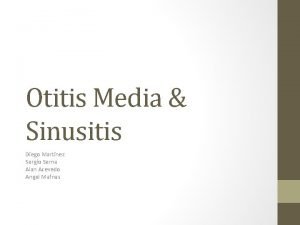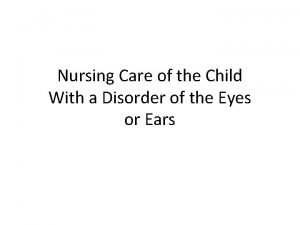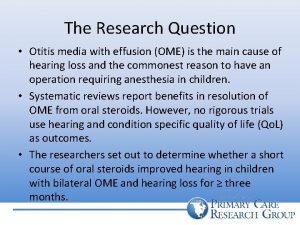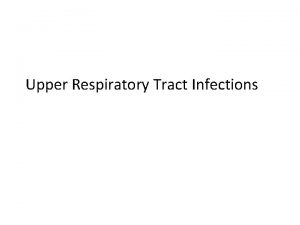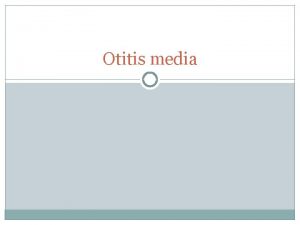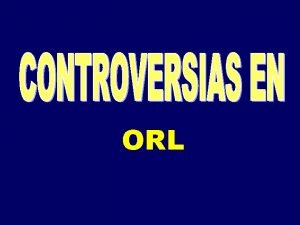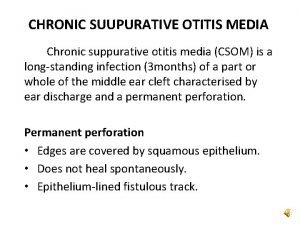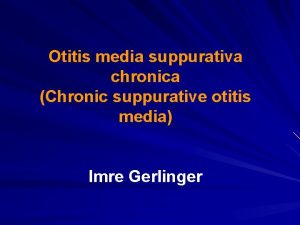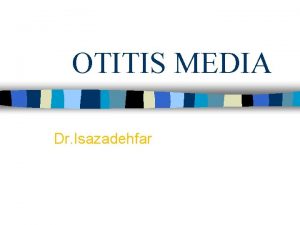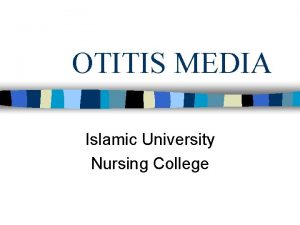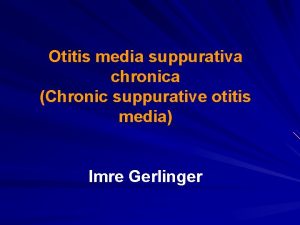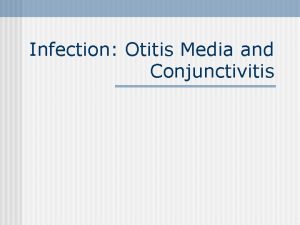Management of Otitis Media with Effusion OME in



















- Slides: 19

Management of Otitis Media with Effusion (OME) in primary care Kifayat Ullah Core Surgical Trainee East of England Deanery

Objectives 1. Background and prevalence of OME 2. Distinguishing OME from AOM 3. Risk factors of OME 4. Audit on OME management 5. Conclusion

Background • OME or “glue ear” commonest cause of childhood hearing impairment • Inflammation of middle ear with collection of liquid in middle ear space • Peak 2 -6 years of age • 85% of children experience fluid in ears following infection • 50% resolve within 3 months

Prevalence of OME • 1993 - 1995 (NCHS), 2 OM accounted for § 18% ambulatory visits (1 -4 yr) § 14% visits during the 1 st yr of life • OME episodes diagnosed 2 § 81% in pediatric practices § 13% in hospital ED § 6% in hospital outpatient departments

Distinguishing OME from AOM

Risk factors of OME • Host factors § § Age/Gender Genetic predisposition Cleft palate/Down syndrome Allergy/Immunity • Environmental factors § § § Daycare/Siblings Bottle (versus breast) feeding Pacifier use Smoking Low socioeconomic status Season/Upper respiratory infections

Why do this audit? Unnecessary visits to ENT clinic Parents frustration why symptoms have not resolved OME management not understood in community

Audit • Prospective study run in ENT outpatient clinic at Tunbridge Wells Hospital, Kent • 250 children aged between 2 and 10 years of age referred from primary care • Data collected prospectively in the form of a questionnaire • New referrals recruited over 12 month period

Main standards in audit Referral orientation for primary care Where OME is strongly suspected to have occurred irrespective of a known ear infection or to have continued for more than 1 month refer: Under 4 years of age: To the second tier community audiology clinic for hearing assessment. Subject to resources and efficiency of booking, this is usually the most direct route to valid audiometry. • Over four years of age: To children’s ENT clinic for hearing assessment Watchful waiting is the initial management, unless there are overriding concerns about hearing, speech or language development accompanying an established history, or unless this has already occurred as set out above. •

Questionnaire: Initial referrals and management of OME

Results Age 6 -10 16% 2 -5 84%

Results

Results • No hearing test in community • All children reviewed developed conductive hearing loss • Tympanograms = type B in 90% of children • True OME in 90% of children examined • 10% of children have had recent AOM • 10% delay in development of speech

Discussion • Most children managed in community not managed according to guidelines • OME management not understood to indicate an optimal strategy • Concern regarding hearing test where none of the children had this performed prior to ENT visit

Discussion • OME huge impact on speech development and educational performance • 30% of children had delay in speech and development • Treatment for OME should initially start with ‘watchful waiting’ – 64% children started on decongestants/antihistamines/antibiotics

Changes made • Standards had not been met mainly due to lack of knowledge in management of OME • Following action plan: ØPresentation at GP trainee teaching sessions Ø Leaflet and poster distribution to GP clinics Ø Develop a checklist for GP doctors in community when assessing children with possible OME • Currently – action plans have been implemented and re-audit is currently active

Conclusion • Audit indicates OME management needs appropriate decision making • Concerns raised regarding audiology services in the community • After a watchful waiting period- refer to ENT clinic if no improvement for further management

References • • • Audit Commission access to care 2002 http: //www. audit-commission. gov. uk/reports/accessible. asp? Prod. ID=D 4361 C 80 -E 5 CB-11 d 6 - B 1 E 10060085 F 8572 Accessed 13/12/06 1 Lous J, Burton MJ, Felding JU, Oveson T, Wake M, Williamson IG. Grommets (ventilation tubes) for hearing loss associated with otitis media with effusion in children. (Cochrane Review). In: The Cochrane Library, Issue 4, 2002. Oxford: Update Software. 2 Williamson I. (1999). Otitis media with effusion. Clinical Evidence: 2: 206 -212. BMJ Publishing, London. 3 Williamson I. (2002) Otitis media with effusion. Clinical Evidence 7: 477 -480. BMJ Publishing, London. 4 Cohen H, Friedman EM, Lai D, Pellicer M, Duncan N, Sulek M (1997) Balance in children with otitis media with effusion. Int J Ped Otorhinolaryngol 42, 107 -115. 5 Bluestone CD, Gates GA, Klein JO, Lim DJ, Mogi G, Ogra PL, Paparella MM, Paradise J, Tos M. (2002). Definitions, Terminology and Classification of otitis media. In: Lim D (ed). Recent advances in otitis media. Ann Otol Rhinol Laryngol. (supp). 111: 8 -18. 6 Effective Health Care Bulletin. No. 4, (1992) The Treatment of Persistent Glue Ear in Children Effective Health Care Bulletin (4), University of Leeds, ISSN: 0965 -0288. 7 Haggard M. (2003) MRC randomised trial on surgical treatment of OME (“glue ear”) in children – 50 findings from TARGET and related HSR & epidemiological studies. March 2003. MRC- ESS in Children’s Middle Ear Disease, Cambridge. (Unpublished report).

Questions?
 Otitis media with effusion otoscopy
Otitis media with effusion otoscopy Aom vs ome
Aom vs ome Clasificación de la otitis media
Clasificación de la otitis media Clasificación de la otitis media
Clasificación de la otitis media Clasificación de la otitis media
Clasificación de la otitis media Adhesive otitis media
Adhesive otitis media Icd x gangguan pendengaran
Icd x gangguan pendengaran Serous vs mucoid
Serous vs mucoid Nonsuppurative otitis media
Nonsuppurative otitis media Weber rinne
Weber rinne Tympanosclerosis
Tympanosclerosis What does fluid in the ear look like
What does fluid in the ear look like Wikimedia
Wikimedia Fpnotebook otitis media
Fpnotebook otitis media Otitis media serosa
Otitis media serosa Complications of otitis media
Complications of otitis media Otitis media ppt
Otitis media ppt Nursing diagnosis for otitis media slideshare
Nursing diagnosis for otitis media slideshare Classification of otitis media
Classification of otitis media Slent eyes
Slent eyes
